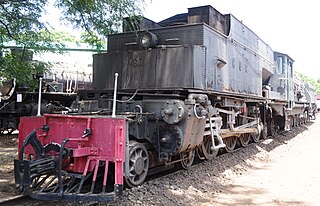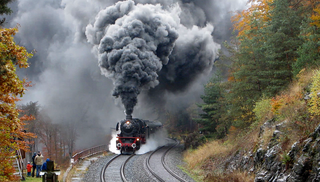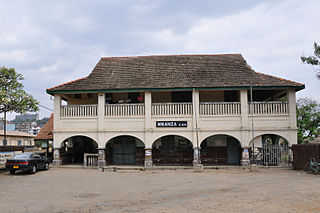
The KUR EC3 class, later known as the EAR 57 class, was a class of 1,000 mm gauge 4-8-4+4-8-4 Garratt-type articulated steam locomotives. The twelve members of the class were built by Beyer, Peacock & Co. in Manchester, England, for the Kenya-Uganda Railway (KUR). They entered service between 1939 and 1941, and were later operated by the KUR's successor, the East African Railways (EAR).
The KUR EC1 class, later known as the EAR 50 class and the EAR 51 class, was a class of 1,000 mm gauge 4-8-2+2-8-4 Garratt-type articulated steam locomotives.
The KUR EC2 class, later known as the EAR 52 class, was a class of 1,000 mm gauge 4-8-2+2-8-4 Garratt-type articulated steam locomotives.
The TR GA class, later known as the EAR 53 class, was a class of 1,000 mm gauge 4-8-2+2-8-4 Garratt-type articulated steam locomotives. The three members of the class were built in 1930 by Beyer, Peacock & Co. in Manchester, England, for the Tanganyika Railway (TR). They entered service in 1931, and, with one exception, were later operated by the TR's successor, the East African Railways (EAR).

The KUR EA class, later known as the EAR 28 class, was a class of 1,000 mm gauge 2-8-2 steam locomotives. The six members of the class were built in 1928 for the Kenya-Uganda Railway (KUR) by Robert Stephenson and Company in Darlington, England, and were later operated by the KUR's successor, the East African Railways (EAR).
The EAR 29 class was a class of oil-burning 1,000 mm gauge 2-8-2 steam locomotives based upon the Nigerian Railways River class. The 31 members of the 29 class were built for the East African Railways (EAR) in two batches, of 20 and 11 locomotives respectively, by North British Locomotive Company in Glasgow, Scotland.
The EAR 30 class was a class of oil-burning 1,000 mm gauge 2-8-4 steam locomotives. The class was built in 1955 by North British Locomotive Company in Glasgow, Scotland, for the East African Railways (EAR). Its design was derived from the 2-8-2 EAR 29 class, which, in turn, was based upon the Nigerian Railways River class.

The EAR 31 class was a class of oil-burning 1,000 mm gauge 2-8-4 steam locomotives. The 46 members of the class were built in 1955 by Vulcan Foundry, in Newton-le-Willows, Lancashire, England, for the East African Railways (EAR). They were a lighter, branch-line version of the EAR 30 class, and worked from various sheds throughout the EAR system.

The KUR EC4 class, later known as the EAR 54 class, was a class of 1,000 mm gauge 4-8-2+2-8-4 Garratt-type articulated steam locomotives developed under and for use in wartime conditions.

The TR DL class, later known as the EAR 23 class, was a class of 1,000 mm gauge 4-8-0 steam locomotives derived from the Nigerian Railways Emir class. The six members of the DL/23 class were built by Beyer, Peacock & Co. in Gorton, Manchester, England, for the Tanganyika Railway (TR). They entered service on the TR in 1923, and were later operated by the TR's successor, the East African Railways (EAR).
The TR MK class, later known as the EAR 25 class, was a class of 1,000 mm gauge 2-8-2 steam locomotives. The eleven members of the class were built by Vulcan Foundry, in Newton-le-Willows, Lancashire, England, for the Tanganyika Railway (TR). They entered service on the TR in 1925–1926, and were later operated by the TR's successor, the East African Railways (EAR).

The EAR 60 class, also known as the Governor class, was a class of 1,000 mm gauge 4-8-2+2-8-4 Garratt-type articulated steam locomotives built for the East African Railways as a development of the EAR's existing 56 class.
The TR ML class, later known and expanded as the EAR 26 class, was a class of 1,000 mm gauge 2-8-2 steam locomotives designed for and ordered by the Tanganyika Railway (TR), as a development of the TR MK class.
The EAR 27 class was a sub-class of 1,000 mm gauge 2-8-2 USATC S118 Class steam locomotives. The first eight members of the class were built in 1944, and were acquired second hand by the Tanganyika Railway (TR) from the Malayan Railways in 1949. By the time these eight locomotives entered service on the Central Line in Tanganyika in 1949, the TR had been succeeded by the East African Railways (EAR), which designated them for a very short time as its MR class, but then, as part of a comprehensive reclassification of all of its locomotives, redesignated them as its 27 class.

The KUR ED1 class was a class of 1,000 mm gauge 2-6-2 T steam locomotives built for the Kenya-Uganda Railway (KUR). The 27 members of the ED1 class entered service on the KUR between 1926 and 1930. They were later operated by the TR's successor, the East African Railways (EAR), and reclassified as part of the EAR 11 class.

The KUR EC5 class was a class of 1,000 mm gauge 4-8-4+4-8-4 Garratt-type articulated steam locomotives built during the latter stages of World War II by Beyer, Peacock & Co. in Gorton, Manchester, England, for the War Department of the United Kingdom. The two members of the class entered service on the Kenya-Uganda Railway (KUR) in 1945. They were part of a batch of 20 locomotives, the rest of which were sent to either India or Burma.

The TR GSL class was a class of 1,000 mm gauge 0-4-0 T geared steam locomotives built by Sentinel Waggon Works in Shrewsbury, Shropshire, England, for the Tanganyika Railway (TR).
The EAR 13 class was a class of 1,000 mm gauge 4-8-2 T steam locomotives built by North British Locomotive Company in Glasgow, Scotland, for the East African Railways (EAR).
The EAR 12 class was a class of 1,000 mm gauge 2-6-2 T steam locomotives built by W. G. Bagnall in Stafford, England, in 1950. The class had been ordered by the Tanganyika Railway (TR) as its SS class, and was a modified and updated version of the TR's existing ST class.
The TR NZ class, later known as the EAR 22 class, was a class of 1,000 mm gauge 4-8-0 steam locomotives built in 1915 by Nasmyth, Wilson and Company in Patricroft, Salford, England. The class had been ordered by the Nizam's Guaranteed State Railway (NGSR) for operation on its network in the Dominion of Nizam, better known as the Hyderabad State, in India. However, the locomotives in the class were never delivered to the NGSR, and, in the end, served their entire working lives in Tanganyika, East Africa.














